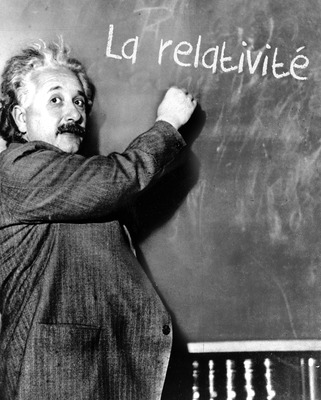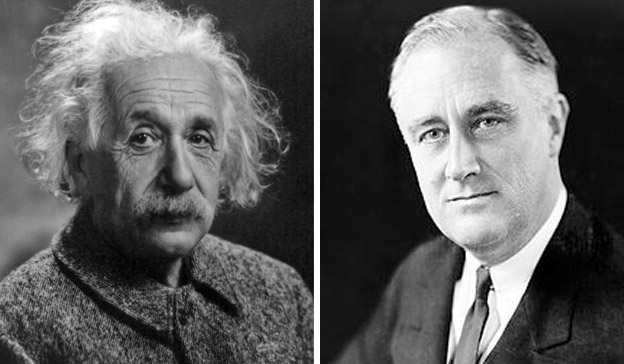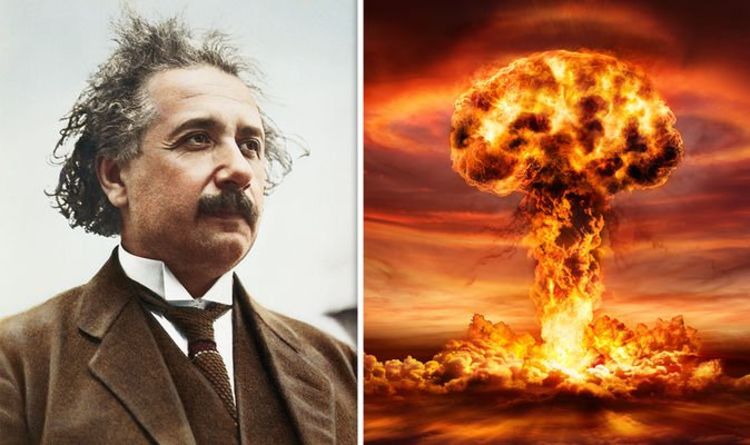A Truly Beautiful Mind - Summary

This story is a biography of Albert Einstein. He was a German born physicist who developed the theory of relativity, one of the two pillars of modern physics. He is regarded as a visionary and world citizen. The story tries to show that how in the beginning he could not speak and then because of his beautiful mind became genius. Over time, the name Einstein became synonym for genius. His work changed our understanding of space, time and the entire cosmos.
Below Average
Albert Einstein was bom on 14 March 1879 at Ulm in Germany. His mother thought he was a abnormal as his head was too large. Einstein didn’t speak until the age of two-and-a-half and when he did learn to speak, he uttered everything twice. His playmates called him "Brother Boring". So he played by himself much of the time. However, he loved mechanical toys.

Once the headmaster at also told his father that his son would never be successful, whatever career he took up. His mother wanted him to learn the violin when was six-years old. So, he started learning it and later became a gifted amateur violinist. He maintained this skill throughout his life.

Interested in Mathematics and Physics
Einstein was not a bad student. He went to high school in Munich and got good marks in almost every subject. But he did not like the school’s strict discipline and left it for good at the age of 15. He wanted to continue his higher education as he had deep interest in mathematics and physics. He joined a university in Zurich because the atmosphere there was more liberal than Munich.
Met Mileva Maric
There he met a fellow student, Mileva Maric who was equally intelligent and clever. They fell in love and finally married in 1903 after Einstein got a job on completing his university studies. Her mother was not happy with this marriage as she thought she was too old for him.and was a book like him.The couple was gifted with two sons. But their marriage didn’t last long and they finally divorced in 1919.

After completing his university education, Einstein badly needed a job. He started his career as a teaching assistant and gave private lessons. Finally, in 1902, he secured a job as a technical expert in the patent office in Bern.
Theory of Relativity
Though his job was to assess other people’s inventions but he worked secretly on his idea on relativity. He published his Special Theory of Relativity in 1905, according to which time and distance are not absolute.

This was followed by the world famous formula which describes the relationship between mass and energy: E = mc2, where E stands for energy, m for mass and c for the speed of the light in a vacuum. In 1915, he published his General Theory of Relativity, which gave an absolutely new interpretation of gravity.

Nobel Prize
This theory established Einstein’s fame in the world of science. In 1919, during a solar eclipse, his theory came out be accurate which brought a scientific revolution. In 1921, he received the Nobel Prize for Physics. After this, he became a world figure. He was showered with honours and invitations from all over the world.

Concern for Atomic Bomb
In 1933, Einstein emigrated to the United States as the Nazis had come to power in Germany. He was deeply worried about atomic bomb. So, when Germany developed the principle of nuclear fission in 1938, he became the first person to raise his voice against it.
He wrote a letter to the American President, Franklin D. Roosevelt on 2 August, 1939 to warn him against Germany’s building of an atomic bomb. This made the Americans develop their own atomic bomb in secret which they used against Japan in August 1945.

As a result, the two Japanese cities named Hiroshima and Nagasaki were totally destroyed. The large scale destruction that it caused shook Einstein from within.
World Citizen
He then involved in politics and started a campaign for peace and democracy He also wrote an open letter to the United Nations proposing the formation of a world government. He started agitating for an end to the arms buildup. He continued his struggle till his death in 1955 at the age of 76. He was celebrated as a visionary and world citizen as much as a scientific genius.

यह कहानी अल्बर्ट आइंस्टीन की जीवनी है। वह एक जर्मन जन्म के भौतिक विज्ञानी थे जिन्होंने सापेक्षता के सिद्धांत को विकसित किया, जो आधुनिक भौतिकी के दो स्तंभों में से एक था। उन्हें एक दूरदर्शी और विश्व नागरिक माना जाता है। कहानी यह दिखाने की कोशिश करती है कि शुरुआत में वह कैसे नहीं बोल सकता था और फिर अपने खूबसूरत दिमाग के कारण प्रतिभाशाली बन गया। समय के साथ, आइंस्टीन नाम जीनियस का पर्याय बन गया। उनके काम ने अंतरिक्ष, समय और पूरे ब्रह्मांड की हमारी समझ को बदल दिया।
औसत से
कम
अल्बर्ट आइंस्टीन 14 मार्च 1879 को जर्मनी के उल्म में बम थे। उसकी माँ ने सोचा कि वह एक असामान्य थी क्योंकि उसका सिर बहुत बड़ा था। आइंस्टीन दो-ढाई साल की उम्र तक नहीं बोलते थे और जब उन्होंने बोलना नहीं सीखा, तो उन्होंने दो बार सब कुछ बोल दिया। उनके प्लेमेट ने उन्हें "ब्रदर बोरिंग" कहा। इसलिए उन्होंने खुद को बहुत समय तक खेला। हालाँकि, उन्हें यांत्रिक खिलौने बहुत पसंद थे.
एक बार हेडमास्टर ने अपने पिता से यह भी कहा कि उनका बेटा कभी भी सफल नहीं होगा, चाहे वह कोई भी करियर बनाए। उनकी मां चाहती थीं कि जब वह छह साल के थे, तो उन्होंने वायलिन सीख लिया। इसलिए, उन्होंने इसे सीखना शुरू कर दिया और बाद में एक प्रतिभाशाली शौकिया वायलिन वादक बन गए। उन्होंने जीवन भर इस कौशल को बनाए रखा।
गणित और
भौतिकी में रुचि
आइंस्टीन
एक बुरा छात्र नहीं था। वह म्यूनिख के हाई स्कूल में गए और लगभग हर विषय में अच्छे
अंक प्राप्त किए। लेकिन उन्हें स्कूल का सख्त अनुशासन पसंद नहीं आया और उन्होंने
15 साल की उम्र में इसे छोड़ दिया। वे अपनी उच्च शिक्षा जारी रखना चाहते थे
क्योंकि उनकी गणित और भौतिकी में गहरी रुचि थी। वह ज्यूरिख में एक विश्वविद्यालय
में शामिल हो गए क्योंकि वहां का माहौल म्यूनिख की तुलना में अधिक उदार था।
वहाँ उनकी मुलाकात एक साथी छात्र, मिलेवा मारिक से हुई जो समान रूप से बुद्धिमान और चतुर था। उन्हें प्यार हो गया और आखिरकार 1903 में आइंस्टीन को अपनी यूनिवर्सिटी की पढ़ाई पूरी करने के बाद नौकरी मिल गई। उसकी माँ इस शादी से खुश नहीं थी क्योंकि वह सोचती थी कि वह उसके लिए बहुत पुरानी है। और उसकी तरह एक किताब थी। इस दंपति को दो बेटों के साथ उपहार दिया गया था। लेकिन उनकी शादी लंबे समय तक नहीं चली और आखिरकार 1919 में उनका तलाक हो गया
अपनी विश्वविद्यालय की शिक्षा पूरी करने के बाद, आइंस्टीन को बुरी तरह से नौकरी की आवश्यकता थी। उन्होंने अपने करियर की शुरुआत एक सहायक के रूप में की और निजी सबक दिए। अंत में, 1902 में, उन्होंने बर्न में पेटेंट कार्यालय में तकनीकी विशेषज्ञ की नौकरी हासिल की।
सापेक्षता
का सिद्धांत
हालांकि उनका काम अन्य लोगों के आविष्कारों का आकलन करना था, लेकिन उन्होंने अपने विचार पर सापेक्षता पर गुप्त रूप से काम किया। उन्होंने 1905 में अपनी विशेष थ्योरी ऑफ रिलेटिविटी प्रकाशित की, जिसके अनुसार समय और दूरी निरपेक्ष नहीं हैं।
इसके बाद विश्व प्रसिद्ध फार्मूला था जो द्रव्यमान और ऊर्जा के बीच के संबंध का वर्णन करता है: E = mc2, जहां E ऊर्जा के लिए खड़ा है, द्रव्यमान के लिए m और c के लिए निर्वात में प्रकाश की गति। 1915 में, उन्होंने अपना जनरल थ्योरी ऑफ़ रिलेटिविटी प्रकाशित किया, जिसने जीआर की बिल्कुल नई व्याख्या दी
इस सिद्धांत ने विज्ञान की दुनिया में आइंस्टीन की प्रसिद्धि स्थापित की। 1919 में, एक सूर्य ग्रहण के दौरान, उनका सिद्धांत सटीक था जो वैज्ञानिक क्रांति लाया। 1921 में, उन्हें भौतिकी का नोबेल पुरस्कार मिला। इसके बाद, वह एक विश्व व्यक्ति बन गया। उन्हें दुनिया भर के सम्मानों और निमंत्रणों से नवाजा गया।
परमाणु
बम के लिए चिंता
1933 में, आइंस्टीन संयुक्त राज्य अमेरिका में चले गए क्योंकि जर्मनी में नाजियों ने सत्ता में आई थी। वह परमाणु बम को लेकर बहुत चिंतित था। इसलिए, जब जर्मनी ने 1938 में परमाणु विखंडन के सिद्धांत को विकसित किया, तो वह इसके खिलाफ आवाज उठाने वाले पहले व्यक्ति बन गए।
उन्होंने 2 अगस्त, 1939 को अमेरिकी राष्ट्रपति, फ्रैंकलिन डी। रूजवेल्ट को एक पत्र लिखा, जिसमें उन्होंने जर्मनी को परमाणु बम बनाने के खिलाफ चेतावनी दी थी। इसने अमेरिकियों को गुप्त रूप से अपना परमाणु बम विकसित किया जो उन्होंने अगस्त 1945 में जापान के खिलाफ इस्तेमाल किया।
परिणामस्वरूप, हिरोशिमा और नागासाकी नाम के दो जापानी शहर पूरी तरह से नष्ट हो गए। बड़े पैमाने पर विनाश कि यह आइंस्टीन भीतर से हिलाकर रख दिया।
वैश्विक
निवासी
इसके
बाद वे राजनीति में शामिल हो गए और उन्होंने शांति और लोकतंत्र के लिए एक अभियान
शुरू किया। उन्होंने संयुक्त राष्ट्र को एक खुला पत्र लिखकर विश्व सरकार के गठन का
प्रस्ताव दिया। उन्होंने हथियार बनाने के लिए आंदोलन शुरू किया। उन्होंने 1955 में
76 वर्ष की आयु में अपनी मृत्यु तक अपना संघर्ष जारी रखा। उन्हें एक दूरदर्शी और
विश्व नागरिक के रूप में एक वैज्ञानिक प्रतिभा के रूप में मनाया जाता था।
